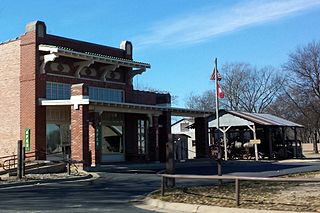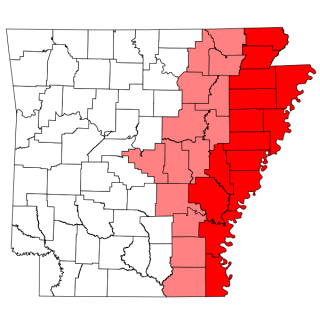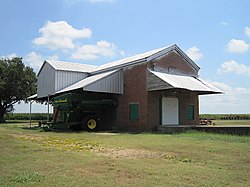
Scott is an unincorporated community and census-designated place (CDP) in Lonoke and Pulaski counties in the central part of the U.S. state of Arkansas. Per the 2020 census, the population was 97. It is part of the Little Rock–North Little Rock–Conway Metropolitan Statistical Area.
Stateburg is a census-designated place (CDP) in the High Hills of Santee in Sumter County, South Carolina, United States. The population was 1,380 at the 2010 census. It is included in the Sumter, South Carolina Metropolitan Statistical Area. Stateburg is located within the larger Stateburg Historic District.

The Jarrell Plantation State Historic Site is a former cotton plantation and state historic site in Juliette, Georgia, United States. Founded as a forced-labor farm worked by John Jarrell and the African American people he enslaved, the site stands today as one of the best-preserved examples of a "middle class" Southern plantation. The Jarrell Plantation's buildings and artifacts all came from the Jarrell family, who farmed the land for over 140 years. Located in the red clay hills of the Georgia piedmont, It was added to the National Register of Historic Places in 1973. It is a Georgia state park in Jones County.

The Arkansas Delta is one of the six natural regions of the state of Arkansas. Willard B. Gatewood Jr., author of The Arkansas Delta: Land of Paradox, says that rich cotton lands of the Arkansas Delta make that area "The Deepest of the Deep South."

The High Hills of Santee, sometimes known as the High Hills of the Santee, is a long, narrow hilly region in the western part of Sumter County, South Carolina. It has been called "one of the state's most famous areas". The High Hills of Santee region lies north of the Santee River and east of the Wateree River, one of the two rivers that join to form the Santee. It extends north almost to the Kershaw county line and northeasterly to include the former summer resort town of Bradford Springs. Since 1902 the town has been included in Lee County.

Shotwell is an unincorporated community in rural eastern Wake County, North Carolina, United States, located about 4 miles (6.4 km) south of Knightdale and 11 miles (18 km) east of Raleigh at the confluence of Smithfield, Mial Plantation, Major Slade, Grasshopper, and Turnipseed Roads. Shotwell has been inhabited since the early 19th century and is home to a number of historic structures. A post office was established in 1883 but closed less than two decades later.

Highway 163 is a north–south state highway in Northeast Arkansas. The highway begins at Wittsburg and runs 42.57 miles (68.51 km) northeast to Highway 1, Highway 1 Business (AR 1B) and Crowley's Ridge Parkway (CRP) in Jonesboro. A spur route runs in Jonesboro. All routes are maintained by the Arkansas Department of Transportation (ArDOT). Almost all of the route is concurrent with Crowley's Ridge Parkway, with a portion also serving as an Arkansas Heritage Trail for its use during the Civil War.

This is a list of the National Register of Historic Places listings in Poinsett County, Arkansas.

The Stone Plantation, also known as the Young Plantation and the Barton Warren Stone House, is a historic Greek Revival-style plantation house and one surviving outbuilding along the Old Selma Road on the outskirts of Montgomery, Alabama. It had been the site of a plantation complex, and prior to the American Civil War it was known for cotton production worked by enslaved people.

Lakeport Plantation is a historic antebellum plantation house located near Lake Village, Arkansas. It was built around 1859 by Lycurgus Johnson with the profits of slave labor. The house was restored between 2003 and 2008 and is now a part of Arkansas State University as a Heritage site museum.

The Walnut Hill Historic District is a collection of 40 family dwellings, agricultural outbuildings, and other structures and sites associated with the Walnut Hill Plantation and the Mial-Williamson and Joseph Blake farms near Shotwell, North Carolina. The historic district represents the post-Civil War growth of one of the largest agricultural centers in Wake County. It is situated primarily along the northeast end of Mial Plantation Road between its intersections with Major Slade and Smithfield Roads.
Indian Bay is an unincorporated community and census-designated place (CDP) in southern Monroe County, Arkansas, United States, in the Arkansas Delta. Indian Bay is on the eastern bank of the White River, 4 miles (6 km) east of St. Charles. For purposes of the U.S. Census, Indian Bay is within Montgomery-Smalley Township. The Baytown Site, a Pre-Columbian Native American archaeological site, is located near Indian Bay. The community was first listed as a CDP in the 2020 census with a population of 15.

Judd Hill is an unincorporated community in Poinsett County, Arkansas, United States. Judd Hill is located on Arkansas Highway 214, 5 miles (8.0 km) south of Trumann. The Judd Hill Cotton Gin, which is listed on the National Register of Historic Places, is located in Judd Hill. Judd Hill was named for banker and businessman Orange Judd Hill, who founded the community.

The John P. Fisher House is a historic plantation house on the shores of Bayou Bartholomew in Ashley County, Arkansas, west of the city of Portland. The two story wood frame Greek Revival house is located north of the junction of Arkansas Highway 160 and County Road 50, west of the bayou bridge. It is also known as the Moats House.

The John H. Johnston Cotton Gin Historic District encompasses a historic cotton gin in the small community of Levesque, Arkansas. The main building of the gin was built in 1941, and was built out of reinforced concrete, instead of the more usual steel, owing to a metal shortage in World War II. It has some Moderne styling, with smooth surfaces and rounded corners. The gin also distinctively incorporates a seed storage facility at its rear. Its ancillary structures, which include a shed, privy, and cyclone structure, are wood-framed with metal siding and roofing.

The Lepanto Commercial Historic District encompasses the traditional commercial heart of the small city of Lepanto, Arkansas. The district includes one block of Greenwood Avenue between Berry and Holmes Streets, and portions of two more blocks at either end, as well as two blocks of Berry Street, with a few buildings on adjacent streets. Lepanto was founded in 1903, but its surviving commercial architecture only dates as far back as c. 1915, when the Portis Company cotton gin was built at the eastern end of the district. Other early buildings include the triangular c. 1920 Arlington Light and Power building at 320 Greenwood, and the unusual Barton's of Lepanto building at 111 Berny Street, built as a wood frame lumber yard office c. 1920; its walls were bricked in 1955 when it was converted to a hardware store.

The Floyd Cotton Gin is a historic cotton gin at the junction of Arkansas Highway 31 and Arkansas Highway 305 in Floyd, Arkansas, USA. It is a two-story wood-frame building roughly L-shaped with a single-story section extending its southern end and a two-story section projecting east under a continuation of the sloping gabled roof. This gin was built in the 1930s, when White County was one of the nation's leading producers of cotton. It is one of five gins in the county to survive from that period. In early 2022, the cotton gin was torn down for unknown reasons.

Frogmore Plantation is an historic, privately owned cotton plantation complex, located near Ferriday in Concordia Parish, Louisiana. Since 1997, Frogmore Plantation is a working farm, tourist attraction featuring many structures, and educational center. Buildings on the site include a cotton gin, and a plantation manor house named Gillespie. Formerly this plantation relied on enslaved African American labor.
The Laurel Hill Plantation in Jefferson County, Mississippi near Rodney, Mississippi was a historic plantation. It is located about two miles southeast of Rodney, in a bend of the Mississippi River named "Petit Gulf". It is significant for the architecture of its main plantation house and for the development of Petit Gulf cotton, a cotton hybrid, on its property.

The Plantation Agriculture Museum is a local museum in Scott, Arkansas, on the Pulaski County and Lonoke County line, approximately 12 mi (19 km) east of Little Rock, Arkansas. The museum park is located in the Arkansas River lowlands on the north shore of Horseshoe Lake. The General Store and Post Office buildings are constructed in the Prairie Style of architecture.

















